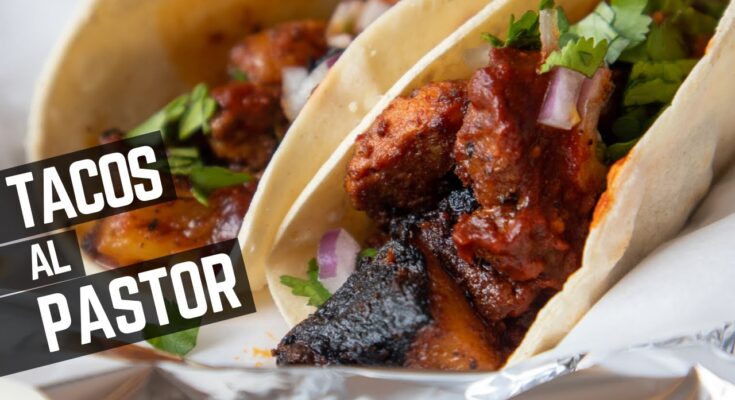Al Pastor Tacos Recipe: There’s something magical about the flavor-packed bite of an authentic Al Pastor taco. Smoky, sweet, spicy pork piled into a soft corn tortilla, topped with juicy pineapple, chopped onions, and cilantro—it’s the kind of taco that makes your taste buds dance. This step-by-step guide walks you through creating restaurant-quality Al Pastor tacos right at home.
What Are Al Pastor Tacos?
Al Pastor tacos are one of Mexico’s most beloved street foods. “Al Pastor” translates to “in the style of the shepherd,” but don’t be fooled—there’s no lamb involved here. Instead, you get thinly sliced pork that’s been marinated in a rich blend of dried chilies, spices, and pineapple juice. The meat is typically cooked on a vertical spit (similar to shawarma) and shaved off in thin, tender slices.
The defining characteristics of Al Pastor tacos include that deep reddish-orange color, hints of smokiness from dried chilies, the tangy-sweet flavor from pineapple, and the slight char from grilling. Once the pork is cooked to perfection, it’s tucked into small corn tortillas and topped with classic garnishes like diced onions, chopped cilantro, a squeeze of lime, and sometimes a little salsa verde or roja.
These tacos are known not just for their flavor but for their cultural significance. They’re a perfect representation of the blending of Middle Eastern cooking techniques (brought to Mexico by Lebanese immigrants) with traditional Mexican ingredients. That’s fusion at its best.
Origins of Al Pastor
To really appreciate Al Pastor tacos, it’s worth taking a quick dive into their origins. This dish was born out of a cultural mashup in the 1920s and 1930s, when Lebanese immigrants brought shawarma and gyro-style cooking to Mexico. They used vertical spits to cook lamb, slicing the meat off in thin layers. Mexican cooks adapted the technique but replaced lamb with pork, a more common and preferred meat locally.
They also developed a completely different marinade using local ingredients like guajillo chilies, achiote paste, and pineapple juice, which gave the meat that signature tangy, spicy, and slightly sweet flavor. The result was “Tacos al Pastor,” and over the decades, they became a staple in Mexican taquerías.
Ingredients You’ll Need
Essential Ingredients for the Marinade
The flavor of Al Pastor tacos starts with the marinade. This punchy, deep-red marinade is loaded with spices, dried chilies, and acidic elements that break down the meat and infuse it with bold flavor. Here’s what you’ll need for a classic Al Pastor marinade:
- Dried guajillo chilies (3-4): These provide a mild heat and deep color.
- Dried ancho chilies (1-2): For a smoky, slightly sweet base note.
- Achiote paste (2 tbsp): A key ingredient that brings color and earthy flavor.
- Pineapple juice (1 cup): Adds sweetness and helps tenderize the meat.
- White vinegar (2 tbsp): For tang and preservation.
- Garlic cloves (4-5): Flavor booster.
- Ground cumin (1 tsp)
- Dried oregano (1 tsp)
- Smoked paprika (1 tsp)
- Salt and black pepper to taste
These ingredients come together in a blender to create a smooth, rich marinade. If you want to go even deeper with the flavor, consider adding a bit of orange juice or chipotle in adobo for an extra kick.
Meat Selection – Why Pork Shoulder is Ideal
The cut of meat you use for Al Pastor is crucial. Traditionally, pork shoulder (also known as pork butt) is the go-to option. It’s got just the right amount of fat to stay moist and flavorful during cooking, and it soaks up the marinade beautifully.
When preparing at home, aim to slice the pork into thin strips or small chunks. The thinner the slice, the better it mimics the classic “trompo” style. Pork shoulder is relatively inexpensive and available at most grocery stores. You can also ask your butcher to slice it for you if you want even, thin pieces.
Avoid overly lean cuts like pork loin—they tend to dry out quickly, especially when grilled. If pork isn’t your thing, you could use chicken thighs as a substitute, though it won’t taste quite the same.
Toppings and Garnishes
A good taco isn’t complete without the right toppings. Al Pastor tacos have a specific lineup of garnishes that enhance the meat’s flavor rather than overpower it:
- Fresh pineapple (grilled or raw, diced): Adds a burst of sweetness and ties back to the marinade.
- White onion (finely diced): Brings in sharpness and crunch.
- Fresh cilantro (chopped): Brightens everything up.
- Lime wedges: A squeeze of lime cuts through the richness.
- Salsa verde or roja: Optional, but a great way to add heat and moisture.
Corn tortillas are the standard base for Al Pastor. Warm them up slightly on a skillet or directly over a flame for that slight char—it makes all the difference.
Preparing the Al Pastor Marinade
Step-by-Step Marinade Instructions
- Toast the Chilies: Start by removing the stems and seeds from the dried guajillo and ancho chilies. Toast them in a dry skillet over medium heat for 1-2 minutes until they’re fragrant.
- Soak the Chilies: Place the toasted chilies in a bowl of hot water for 10-15 minutes to soften them up.
- Blend the Marinade: In a blender, add the softened chilies, achiote paste, pineapple juice, vinegar, garlic, cumin, oregano, paprika, and salt. Blend until you have a smooth, thick paste.
- Taste and Adjust: Taste your marinade—if it needs more acid, add vinegar. If it’s too spicy, a bit more pineapple juice will mellow it out.
The result should be a bold, tangy, and slightly sweet marinade with a gorgeous deep red color.
Tips for Best Flavor Infusion
To get the most flavor into your pork, make sure it’s sliced thin and evenly coated with the marinade. Use a large bowl or a zip-top bag to marinate, pressing out as much air as possible to ensure full coverage. Marinate for at least 6 hours, though overnight is ideal for maximum flavor absorption.
If you’re short on time, even a couple of hours can do the trick—just make sure the meat is fully coated and kept cold during the marinating process.
Marinating the Pork
Duration and Temperature for Marinating
Once your marinade is ready, the next crucial step is giving it enough time to work its magic on the pork. This isn’t just about flavor; marinating also helps tenderize the meat, making each bite melt in your mouth. The longer the pork soaks in that chili-pineapple goodness, the better it will taste.
For best results, marinate the pork for at least 6 to 12 hours, but if you really want to go the extra mile, leave it overnight—around 18 to 24 hours. This extended time allows the acids and enzymes from the pineapple juice and vinegar to break down the tough fibers in the pork, leaving you with a much more tender texture.
As for temperature, always keep your marinating pork in the refrigerator. Room-temperature marinating might speed things up a bit, but it also increases the risk of bacterial growth—definitely not something you want to play around with when dealing with raw pork.
Pro tip: use a non-metallic container like glass, ceramic, or plastic, since acids in the marinade can react with metal and create off-flavors.
Storing Marinated Pork Safely
Proper storage during marination is essential for both safety and flavor. Here are a few key tips:
- Use an airtight container or zip-top bag: This ensures even coating and prevents odors from spreading in your fridge.
- Label your container with the date and time you started marinating—this keeps you on track.
- Don’t reuse leftover marinade for basting unless you cook it**: Because it’s touched raw meat, it needs to be boiled if you plan to reuse it as a sauce or drizzle later.
- Keep it below 40°F (4°C): This is the food safety gold standard for refrigeration.
If your plans change and you can’t cook the pork right away, you can freeze the marinated meat for up to two weeks. Just thaw it in the fridge overnight before cooking. The flavor will still be bold, and you’ll have saved yourself some prep time.
Cooking the Al Pastor Meat
Traditional Vertical Spit vs. Home Methods
Authentic Al Pastor is cooked on a vertical spit known as a “trompo,” where layers of pork are stacked and slowly roasted while rotating in front of a gas flame or charcoal fire. At the top of the spit, a pineapple often sits, dripping its juices down over the meat as it cooks. It’s mesmerizing to watch and delivers amazing results—but not exactly practical for home cooks.
So how can you recreate that trompo flavor and texture at home?
Home-friendly alternatives include:
- Oven-roasting: Stack marinated pork slices on skewers, then roast them upright in a baking dish.
- Cast iron skillet: This is a great option if you’re short on time. Sear the meat in batches on high heat to get a nice char.
- Grilling: Lay the slices over medium-high heat, flipping once or twice. This method gives a nice smoky flavor, especially over charcoal.
- Air fryer or rotisserie-style toaster oven: If you have these gadgets, you can mimic the trompo-style rotation for even cooking.
While the texture may not be exactly like what you’d get on the street in Mexico City, the flavor will still be deeply satisfying.
Grilling, Pan-Frying, and Oven Techniques
Here’s how to nail the cooking method that works best for your setup:
1. Grilling (Charcoal or Gas):
- Preheat grill to medium-high.
- Oil the grates to prevent sticking.
- Place thin pork slices directly on the grill or use a grill basket.
- Cook each side for 3–5 minutes, until edges are crispy.
- Let rest before chopping into bite-sized pieces.
2. Skillet or Pan-Fry:
- Heat 1–2 tablespoons of oil in a cast iron or heavy skillet.
- Add pork in small batches to avoid steaming.
- Sear for 4–6 minutes, flipping halfway until browned and cooked through.
- Remove from heat and chop.
3. Oven Roasting:
- Preheat oven to 400°F (200°C).
- Stack pork slices on skewers or a vertical roasting rack.
- Roast for 30–40 minutes, turning halfway for even cooking.
- Optional: finish under the broiler for 5 minutes to add some char.
4. Air Fryer:
- Preheat to 375°F.
- Add a single layer of pork slices.
- Cook for 8–10 minutes, shaking the basket halfway through.
Regardless of your cooking method, aim for slight caramelization on the edges—that’s where the magic happens. Don’t overcrowd the meat, and always let it rest for a few minutes before slicing and serving.
Assembling the Tacos
Heating the Tortillas
A taco is only as good as its tortilla. It might seem like a small detail, but properly heating your tortillas takes your Al Pastor tacos from good to great. Corn tortillas are the traditional choice for Al Pastor—soft, slightly nutty, and the perfect vessel for all that flavorful pork.
Here’s how to heat them right:
- On the stovetop: Place a tortilla directly over a gas flame for about 15 seconds per side. This gives you a beautiful char and added flavor.
- In a dry skillet or comal: Heat on medium-high for 30 seconds to 1 minute per side until soft and pliable with a few brown spots.
- In the oven: Wrap a stack of tortillas in foil and heat at 350°F for 10–15 minutes. Great for batch heating.
- Microwave: Wrap a few tortillas in a damp paper towel and microwave in 30-second bursts until warm. Not ideal for texture, but it works in a pinch.
Whatever method you use, don’t skip this step. Cold or undercooked tortillas crack and fall apart—ruining your taco experience.
Once heated, wrap your tortillas in a clean kitchen towel to keep them warm and soft while you assemble the tacos. This keeps everything warm and ready to go when it’s time to serve.
Building the Perfect Al Pastor Taco
Now comes the fun part—putting it all together. You’ve got your beautifully charred pork, warm tortillas, and fresh toppings. Here’s how to build the ultimate Al Pastor taco:
- Lay down your tortilla: Keep it simple—one tortilla per taco. Some taquerías double up, but that’s up to you.
- Add chopped Al Pastor meat: Around 2–3 tablespoons per taco. Make sure it includes some crispy edges for texture.
- Top with diced white onions: Adds crunch and sharpness.
- Sprinkle fresh cilantro: For freshness and color.
- Add pineapple chunks: Whether grilled or fresh, pineapple cuts through the richness and ties everything together.
- Drizzle salsa if desired: A smoky salsa roja or tangy salsa verde both pair beautifully.
- Finish with a squeeze of lime: Brightens every bite.
Serve immediately while everything’s hot. These tacos are meant to be eaten fresh, with juice dripping down your hand—that’s the Al Pastor way.
Serving Suggestions
Sides That Pair Well with Al Pastor Tacos
Tacos Al Pastor can absolutely stand on their own, but if you’re planning a full meal or feeding a crowd, adding some traditional Mexican sides will elevate the whole experience.
Here are some perfect pairings:
- Mexican street corn (Elote): Grilled corn slathered in mayo, cotija cheese, chili powder, and lime.
- Refried beans: Either black or pinto beans mashed and cooked with garlic, onion, and lard or oil.
- Mexican rice: Fluffy rice cooked with tomato, garlic, and chicken broth for a savory side.
- Pico de gallo: Fresh tomato salsa with onion, cilantro, lime, and jalapeño for a cool contrast.
- Guacamole: Creamy and rich, perfect with the spicy pork.
- Tortilla chips with salsa or queso: A crowd-pleaser, especially for gatherings.
Don’t forget to offer cold drinks. Al Pastor tacos are bold and flavorful, so beverages like agua fresca (hibiscus, tamarind, or horchata), Mexican Coke, or light beer like a Pacifico or Modelo help balance the heat and refresh the palate.
Taco Night Tips
If you’re serving these at a taco night or party, consider setting up a DIY taco bar. Lay out:
- Warm tortillas in a covered basket
- Chopped Al Pastor meat in a heated tray
- Bowls of onions, cilantro, pineapple
- Multiple salsas
- Lime wedges
- Optional extras like pickled jalapeños, radishes, or hot sauces
This setup lets everyone customize their tacos and keeps things fun and interactive.
Tips for Perfect Al Pastor Every Time
Common Mistakes to Avoid
Even with a solid recipe, small missteps can throw off your Al Pastor game. Here are some of the most common pitfalls—and how to avoid them:
- Using the wrong cut of meat: Pork shoulder is ideal because it has enough fat to stay juicy. Lean cuts like pork loin will dry out too quickly.
- Skipping the marination time: Don’t rush this step. The marinade needs time to penetrate the meat and infuse it with flavor.
- Overcrowding the pan or grill: This causes the meat to steam instead of sear. Always cook in batches if necessary.
- Not heating the tortillas properly: Cold or stiff tortillas ruin the texture of the taco. Always warm them before serving.
- Using too much or too little pineapple: Pineapple adds a nice sweetness, but too much can make the taco overly sweet. Use it sparingly as a topping rather than mixing it into the meat.
- Overcooking the pork: Aim for slightly crispy edges, but keep the meat tender. Dry pork is nobody’s favorite taco filling.
Flavor Enhancements and Variations
Want to level up your Al Pastor game? Try these expert tweaks:
- Add chipotle in adobo to the marinade for extra smoky heat.
- Use a meat smoker to infuse the pork with a wood-fired flavor that mimics traditional trompo cooking.
- Try pineapple-glazed pork belly for a rich, decadent spin.
- Experiment with tortillas: Blue corn tortillas or hand-pressed varieties can add depth and color to your presentation.
- Toss in pickled red onions or a dash of cotija cheese for a flavor twist.
Al Pastor is a dish that’s ripe for personalization. Stick with tradition or make it your own—either way, you’re in for a mouthwatering experience.
FAQs about Al Pastor Tacos Recipe
Q1: Can I make Al Pastor with chicken instead of pork?
Yes, you can substitute chicken thighs for pork shoulder. While it won’t have the same rich flavor, the marinade still works well with poultry.
Q2: How long can I store leftover Al Pastor meat?
Cooked Al Pastor meat can be stored in the fridge for up to 4 days or frozen for up to 3 months. Reheat in a skillet for best results.
Q3: Is it necessary to include pineapple in the marinade or topping?
Pineapple adds sweetness and tenderizes the meat, but it’s not mandatory. You can leave it out if you prefer a less sweet profile.
Q4: Can I use store-bought achiote paste?
Absolutely. Store-bought achiote paste is a great time-saver and still delivers authentic flavor.
Q5: What’s the best way to reheat Al Pastor tacos?
Reheat the meat in a hot skillet and warm the tortillas separately. Assemble the tacos fresh for the best taste and texture.
Conclusion
Al Pastor tacos are more than just a meal—they’re a journey through history, culture, and flavor. From the rich marinade to the tender, charred pork and fresh toppings, every element plays a crucial role. Whether you’re making them for Taco Tuesday, a backyard cookout, or just because you’re craving something delicious, this step-by-step guide gives you everything you need to make unforgettable tacos al pastor right at home.
So go ahead—get those chilies soaking, marinate that pork, and fire up the grill. Once you take that first bite, you’ll see why Al Pastor remains a king among tacos.



